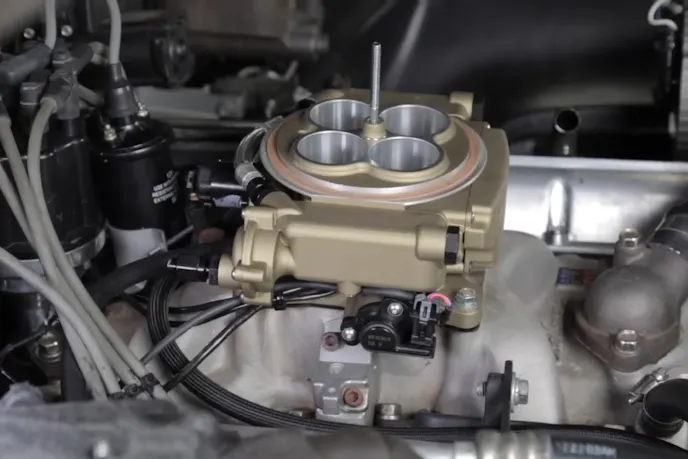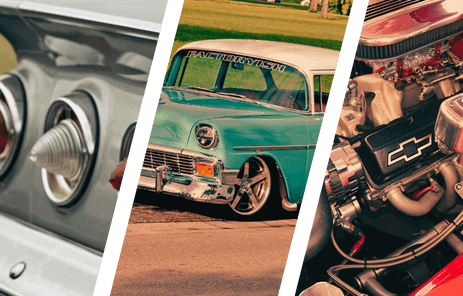The best of both worlds is a classic car with the reliability and drivability of a modern car. If we wanted a modern car, we would trade our classic car for a late-model Camaro or Corvette. But we want to keep the cool vintage styling, so how do we do that? A big upgrade for your classic is swapping to a modern drivetrain like an LS or LT, or doing a carb-to-EFI conversion with the small-block or big-block you already have.
Electronic fuel injection (EFI) isn’t just for modern cars. Aftermarket EFI systems have completely changed the way vintage muscle and classic hot rods are built and driven. This is a performance-driven upgrade that doesn’t rob your car of its soul; it makes it easier to live with, easier to tune, and, in many cases, even a little faster. But there are changes and precautions you need to consider before making the leap from carb to EFI, and we’re here to lay out those challenges.

Why EFI Now Makes More Sense Than Ever
For decades, carburetors dominated the scene. If you were going fast, you were probably doing it with a Holley four-barrel or something close to it. But even the best-tuned carb is still limited by mechanical airflow and fuel delivery. EFI, by contrast, adjusts fuel in real time, based on load, temperature, elevation, and driver input. And thanks to aftermarket EFI systems like Holley’s Sniper EFI and Terminator X, converting from carb to EFI has never been easier.
This isn’t just about convenience, it’s about precision. Whether you’re carving canyons in 100-degree heat or firing up on a freezing morning, EFI makes sure your engine is dialed in every time. It also eliminates one of the biggest pains with carbs: Cold starts. Instead of pumping the gas, praying it catches, and keeping it running with your foot for 45 seconds, you hit the key and go. With an oxygen sensor providing real-time feedback, the system makes constant adjustments, ensuring it always runs at the proper air-fuel ratio. And in today’s world, where pump gas quality and ethanol content can vary wildly from station to station, that adaptability matters more than ever.

TBI Versus MPFI
When upgrading a vintage car or truck with a carb to EFI conversion, you’ve got two main paths: throttle body injection (TBI) or multi-port fuel injection (MPFI). Throttle Body Injection is the easier, more budget-friendly option. Holley’s Sniper EFI bolts right up in place of a traditional four-barrel carb, using the same intake manifold and air cleaner. It simplifies the install while still delivering the benefits of electronic fuel metering.
Fuel is sprayed above the throttle blades, so fuel distribution isn’t as precise as port injection, but for street cars and performance builds, it’s usually more than enough. And the learning curve is short. Once you input a few basic engine specs, the system self-tunes over time while you drive, refining its map with input from the wideband O2 sensor.
Multi-Port Fuel Injection, on the other hand, is for those who want maximum control and precision. It places injectors directly into each intake runner, just like modern OEM systems like you find on an LS engine. This leads to cleaner combustion, sharper throttle response, and the ability to support more aggressive cams or power adders. But it also requires more components, like a new intake manifold, fuel rails, and injectors.
Holley’s Terminator X system gives you that full control. It’s designed for serious performance builds and works seamlessly with boost, nitrous, and advanced ignition setups. If you’re pushing big horsepower or want to fully tune your engine from idle to redline, MPFI is the move.
Building The Fuel System To Match
The first big change you will have to make involves your fuel system. Carburetors use a high-flow, low-pressure fuel pump, usually a mechanical pump bolted to the engine, to supply the carburetor with fuel. But EFI uses high-flow, high-pressure pumps, usually found inside the gas tank, to supply the fuel injectors with pressurized fuel to run properly. There are two common ways to convert your fuel system to the style required by EFI.
The first method is considered to be the easiest for the at-home do-it-yourself wrencher. This is the external fuel pump method. This is where you add an externally mounted in-line electric fuel pump, reusing your stock gas tank and in-tank pickup tube. This method is typically the cheapest and easiest, but has some drawbacks.
Since the pump is not in the tank, the electric fuel pump can tend to be noisy for some. Also, the service life of the fuel pump is shorter than an in-tank setup, as the fuel pump is cooled by the fuel it sits in, and heat is the killer of electric motors.
The second method is the in-tank fuel pump system. This can be done by modifying your stock fuel tank to take an in-tank pump module or a new tank that is designed to take an in-tank pump module. This method is going to cost you more, but if it’s in the budget, it’s usually recommended. The in-tank fuel pump is quieter and lasts longer, and you benefit from a new tank if your classic’s tank has seen better days.
There are several aftermarket options to help — whichever route you choose, some universal fitment and others direct-fit. Tanks inc offers direct replacement fuel tanks that look completely stock but come with baffled in-tank fuel pump modules to make converting your classic from carb to EFI simple and clean. Tanks Inc. also offers universal modules to assist you in converting your stock fuel tank.

One last thing to keep in mind when it comes to your carb to EFI conversion is that the difference in fuel pressure requires parts that can handle high-pressure fuel and modern ethanol content. Fuel filters and rubber hoses for carburetors are usually rated for no more than 15psi and little-to-no ethanol mixed in, while EFI typically runs at 43 to 60psi. Trying to run EFI without upgrading periphery components can result in numerous problems and hazardous fuel leaks.

Wiring And Grounding: The Hidden Essentials
Even the cleanest engine bay won’t help you if your wiring is sketchy. Remember, your classic car may run fine now, but carburetor systems need simple electronics to run, and operate at lower amps than EFI systems. OEM and Aftermarket EFI systems rely on clean, noise-free signals to run correctly. That means using shielded wires where needed and grounding everything properly.
Aftermarket EFI systems include wiring harnesses that are designed to simplify things. These kits include labeled connectors and are laid out for clean routing. Still, the key is grounding. Your battery, engine block, and ECU all need solid, clean ground points. Don’t cut corners here. A poor ground can lead to erratic fuel delivery, no-start conditions, or tuning issues that are difficult to track down. Take the time to run your grounds properly and triple-check your connections before the first startup.

Ignition And Timing Control
When converting your classic small-block or big-block Chevy from carb to EFI using Holley’s Sniper EFI kits, you can utilize your stock distributor and ignition system with no issue. But along with these aftermarket EFI systems is the ability to also benefit from full spark control. By letting the ECU control timing advance based on RPM, load, and even boost pressure, you gain another level of performance and protection.
You’ll likely need to upgrade your ignition system to get full control. That could mean installing a Holley Dual-Sync distributor, a crank trigger, or even coil-on-plug setups, depending on your engine platform. But the payoff is massive and includes more power and torque, better throttle response, and safer operation under all conditions. Plus, it lets you build custom timing maps. You can run more advance at cruise for mileage, then pull timing under WOT for safety. It’s like having a smart ignition that adapts to how you drive.
Self-Tuning Versus Manual Tuning
Both Sniper and Terminator X offer self-learning modes, which are great for beginners with milder street-focused builds. The ECU builds its fuel map as you drive, using the oxygen sensor’s feedback to reach your target air-fuel ratios. This is where your exhaust setup matters.
It’s common in our classic cars and trucks to have exhaust systems that aren’t 100 percent sealed from the cylinder heads to the exhaust tips. Cheap headers with not-so-flat flanges and cheap U-bolt exhaust clamps can be the source of leaks. If you have leaks near the O2 sensor, before or after it, it can throw off readings and confuse the ECU. Make sure your exhaust is leak-free and that the sensor is installed at the correct depth and angle for accurate data. Also, if you have to use a sealant to help seal up your exhaust, be sure it is exhaust and O2 sensor safe.

For advanced users or race cars, manual tuning lets you dial in specific parameters with precision. Using Holley’s software suite, you can adjust VE tables, ignition curves, injector pulse width, and more. It’s powerful, but it requires a basic understanding of tuning theory. If you’re chasing every last horsepower or fine-tuning for specific fuels like E85, manual tuning is the way to go.
Driveability Without Compromise
At the end of the day, Holley’s EFI systems give you modern reliability and tunability without erasing the character of your car. Cold starts, hot restarts, elevation changes, load variations; EFI handles all of it. And with options for everything from mild street cars to 1,000hp monsters, there’s a setup for just about every build.
It’s not about “ruining” the soul of your vintage ride. It’s about making it better. You get to keep the sound, the feel, the raw mechanical joy, but leave the stalling, stumbling, or jet swapping every time the weather shifts in the past where it belongs. For any classic that gets driven regularly, EFI isn’t just an upgrade. It’s an investment in the future of the car.
You might also like
Project Mighty Mouse: AFR SBC Cylinder Heads Elevate Our 327
AFR 210cc SBC cylinder heads and a port-matched intake elevate our 327 c.i. Mighty Mouse build into a high-RPM performer.







